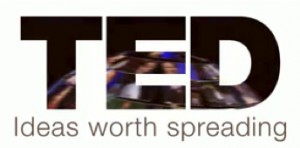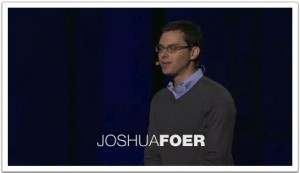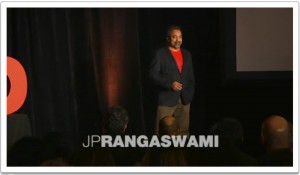Given the demonstrated value of information in modern warfare, one wonders why DoD information systems and shared data services lag so far behind the state of commercial technology?
 When I allow myself idle time, I most often pull up TED talks and browse for something interesting. If you are not familiar with TED talks, I encourage you to check them out. My favorite way to watch TED is on a large screen TV through internet streaming television on a ROKU device. TED is the acronym for Technology, Entertainment and Design. It is now a global set of conferences owned by the private non-profit Sapling Foundation, formed to disseminate “ideas worth spreading.“
When I allow myself idle time, I most often pull up TED talks and browse for something interesting. If you are not familiar with TED talks, I encourage you to check them out. My favorite way to watch TED is on a large screen TV through internet streaming television on a ROKU device. TED is the acronym for Technology, Entertainment and Design. It is now a global set of conferences owned by the private non-profit Sapling Foundation, formed to disseminate “ideas worth spreading.“
 A perfect example of an idea worth spreading is the TED talk “Feats of memory anyone can do” by Joshua Foer. In this short talk, Joshua teaches the audience about the lost art of memory training. Although most of us have learned at one time that our memory works better if we associate images, Joshua, a journalist, explains how anyone can compete in the USA National Memory Championship contest. After he learned the contestants are everyday people and not genius savants, he himself entered the 2006 contest in the “speed cards” event where he set a new record for memorizing the random order of a full deck of cards in 1 minute 40 seconds [a record that has since been lowered to 1 minute 3 seconds].
A perfect example of an idea worth spreading is the TED talk “Feats of memory anyone can do” by Joshua Foer. In this short talk, Joshua teaches the audience about the lost art of memory training. Although most of us have learned at one time that our memory works better if we associate images, Joshua, a journalist, explains how anyone can compete in the USA National Memory Championship contest. After he learned the contestants are everyday people and not genius savants, he himself entered the 2006 contest in the “speed cards” event where he set a new record for memorizing the random order of a full deck of cards in 1 minute 40 seconds [a record that has since been lowered to 1 minute 3 seconds].
I recently listened to a presentation by Saffron Technology, an associative-context based data analytics Company. Their technology takes advantage of the associative power of the human brain as the basis of their data search algorithms. It will be interesting to learn more about the implementation and effectiveness of this technology.
 Another interesting TED talk titled “Information is food” is presented by JP Rangaswami. He tells of his 38 thousand books and a 25 year journey that led him to think of consuming information in the same way he thinks of consuming food. Rangaswami began his journey after he watched the robot in the movie Short Circuit continuously ask for inputs [energy and information]. The movie caused him to wonder if we humans have the equivalent need for the consumption of energy and information. His search helped him understand that human evolution has traded our larger brains for a smaller digestive system. From this work, Rangaswami has concluded that like food, “information is never a production issue – it is always a consumption issue.” By this analogy, information improperly prepared for consumption will not effectively serve the need.
Another interesting TED talk titled “Information is food” is presented by JP Rangaswami. He tells of his 38 thousand books and a 25 year journey that led him to think of consuming information in the same way he thinks of consuming food. Rangaswami began his journey after he watched the robot in the movie Short Circuit continuously ask for inputs [energy and information]. The movie caused him to wonder if we humans have the equivalent need for the consumption of energy and information. His search helped him understand that human evolution has traded our larger brains for a smaller digestive system. From this work, Rangaswami has concluded that like food, “information is never a production issue – it is always a consumption issue.” By this analogy, information improperly prepared for consumption will not effectively serve the need.
Just as information is as important as food for our species, it has always been a critical discriminator in warfare. Precision weapons have only elevated that relationship. A recent front page article in USA Today, U.S. military snipers are changing warfare, is a current example.
 “Typically, a well-equipped sniper in World War II could be expected to hit a human target with a single shot at about 600 yards in favorable conditions and during daylight. Today, snipers can typically hit targets at twice that range — from more than half a mile away — and at night, said Bryan Litz, a ballistics expert at Berger Bullets who has done military contract work.”
“Typically, a well-equipped sniper in World War II could be expected to hit a human target with a single shot at about 600 yards in favorable conditions and during daylight. Today, snipers can typically hit targets at twice that range — from more than half a mile away — and at night, said Bryan Litz, a ballistics expert at Berger Bullets who has done military contract work.”
To be effective, precise and timely information must be gathered, prepared, and consumed by the sniper or the precision weapon. When done well it minimizes collateral damage and creates an effective psychological impact on the enemy. Given the demonstrated value of information in modern warfare, one wonders why DoD information systems and shared data services lag so far behind the state of commercial technology? Fortunately, opportunities for improvement are on the horizon…
… good discussion for a future post.

Marv;
Can’t wait for the next installment on this thread. This is exactly what we’re currently working on, the application of current and evolving commercial technology for DoD utility. I think the biggest issue you may find is not the ability to insert and use the technology, but rather the ability to simply share the information once produced. The DoD exchange infrastructure is just not there yet. It is very fragmented, actually there is no real vision for its future as far as devlopment goes.
A quick thought!
John, it is true that the DoD infrastructure is fragmented. One of my big pushes is to help the DoD seniors understand the importance of infrastructure in the era of enterprise, virtualization, and cloud. We often hear folks touting the value of application libraries such as iPhone but usually do not relate the enabling infrastructure as the real capability behind the application. This has to change if the DoD/Navy is going to take full advantage of the commercial technology…
Marv, as always, spot on regarding the requisite enabling infrastructure to realize the capability. Listening to some of the anti-platform centric pundits might lead one to conclude nobody needs to actually install anything anywhere anymore. It’s all already there, either actually or virtually. Well, in my humble opinion, not in the maritime domain it isn’t. BTW, I am a TED addict… most recently, I thoroughly enjoyed Rory Sutherland’s Perspective Is Everything, although one of my all-time favorites from 5 years ago is Adam Grosser’s absorption refrigerator. Thanks for sharing your thoughts Marv… please don’t stop.
Love this thread, Marv! Going back through your past threads now – not sure how I missed the TED talks.